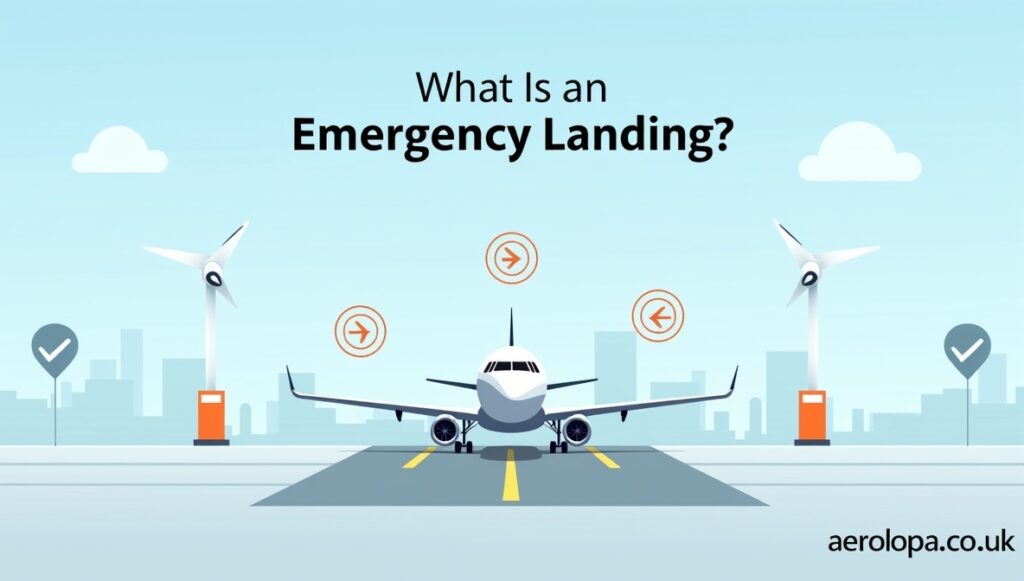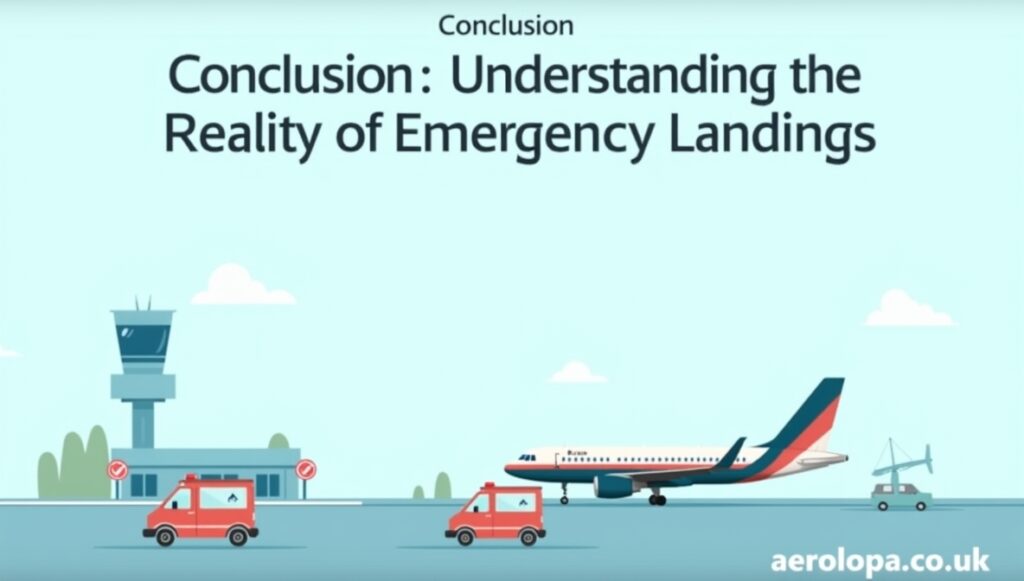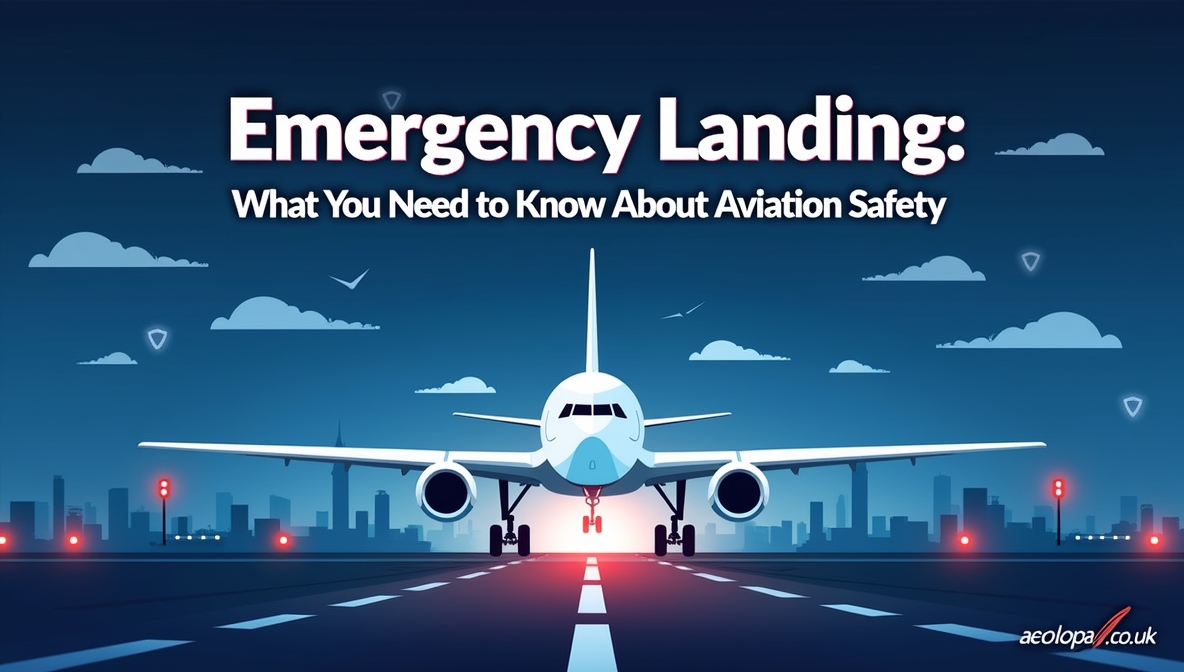When people hear the term emergency landing, they likely imagine flashing lights, oxygen masks, and panicked pilot announcements. What most people do not realize is that many aviation professionals have undergone extensive training in order to perform the vitally important function of an emergency landing as quickly as possible, in a measured way, and while still remaining safe. In fact, as ominous as the term sounds, an emergency landing is safe in most situations due to the aviation safety culture we have in aviation, and the training and experience the pilots have.
Airlines around the globe, including United Airlines, Delta, JetBlue, and FedEx, have recently experienced emergency landings. Each reminder demonstrates not only the challenges of public aviation but also the remarkable safety systems that ensure a safe experience for travelers.
What Is an Emergency Landing?

An emergency landing is a carefully orchestrated process in which an aircraft lands sooner than scheduled due to an unanticipated event affecting the safety of people, crew or aircraft. While emergency landing events are occasionally presented as a chaotic and dangerous situation in movies, emergencies can occur without chaos or danger, depending on how they are handled. In reality, an emergency landing is an inherently structured and professional occurrence resulting from the professionally-trained skills of the crew and staff, emergency services or air traffic control system procedures, at any airport throughout the world.
Emergency landings can take on different forms, but each has its own urgency. A precautionary landing occurs when a pilot makes the prudent decision to divert to the nearest airport after observing unusual readings on the aircraft systems, such as lighting warning indications or, for example, unexpected mechanical sounds. A forced landing occurs when the aircraft is required to land due to an urgent issue, such as an engine failure, fire, or running out of fuel. A ditching scenario occurs when an aircraft must land in the water if no airport is accessible, although this scenario is extremely rare in commercial aviation.
The phrase emergency landing frequently makes the news during a technical or medical problem situation with a major airline mid-flight. United Airlines flight emergency landing in Newark, Delta Connection DL3543 emergency landing due to flap issues, and JetBlue flight emergency landing due to unusual vibrations are examples of precautionary decisions made mid-flight because of situations that have not yet escalated to a serious problem. These situations event to emergency landings are demonstrating the great safety culture of the aviation industry and do not indicate a dangerous situation.
Once a pilot announces an emergency, air traffic control immediately prioritizes that aircraft by clearing other aircraft from its flight path and steering it to an appropriate runway. At the same time, emergency vehicles, including fire trucks, ambulances, and additional personnel have been oriented to a location near that runway just in case the pilot declares an emergency. Meanwhile, inside the cabin and approaching an emergency landing, the flight attendants are preparing the passengers by verifying safety procedures, checking that seatbelts are fastened, and clarifying what to expect once we have descended. In most situations, the passengers often remain unaffected and are unaware of the situation’s severity as the angle of descent is usually minimally different than a normal landing.
One of the reasons emergency landings are so effective is the incredible training and technology behind aviation. Modern aircraft like Boeing and Airbus models are built with multiple backup systems—redundant engines, electrical circuits, and hydraulic lines. Even in cases like the Delta emergency landing MSP flaps or the Hawker 800XP emergency landing MSP, where a technical malfunction forced diversion, pilots relied on backup procedures and landed safely. The same goes for cargo operations, such as the FedEx cargo plane emergency landing, which proved how strict protocols extend beyond passenger flights.
When passengers hear the words “emergency landing,” it can seem troublesome, but the truth is usually much less severe. An emergency landing is merely a precautionary measure taken out of an abundance of safety, and nearly every emergency landing goes well. Aviation authorities, like the FAA and NTSB, closely examine every emergency landing, and this scrutiny continues to raise maintenance standards extremely high. The emergency landing process in every case contributes to improving the safety of aviation, meaning there are lessons for the industry even with every emergency landing.
In the end, one should not see emergency landings as an unsuccessful outcome of aviation, but rather a successful accident of aviation safety, which implies that pilots are vigilant, aircraft systems are reliable, and airlines will put the safety and well-being of their passengers first. If you hear about a United Airlines flight’s emergency landing after landing at Dulles Airport, a JetBlue flight’s emergency landing in response to technical alerts, or a Delta flight’s emergency landing in response to some type of emergency onboard, the outcome was always that it was a safe return, on the surface at least, to the ground. For this reason, air travel, even when faced with unplanned challenges, is the safest mode of transportation.
Notable Recent Cases of Emergency Landings
Airline safety events often attract public attention, especially when news headlines highlight an emergency landing. While these events can sound dramatic, they are usually managed with professionalism, training, and precision. Let’s look closely at some notable cases of emergency landings in recent years and what they reveal about aviation safety.
1. United Airlines Flight Emergency Landing
A United Airlines flight emergency landing became the focus of aviation headlines when a Boeing aircraft developed a technical irregularity mid-flight. Passengers reported hearing unusual engine sounds, and the captain made the decision to divert to the nearest suitable airport.
What stands out is how smoothly the crew handled the incident. Passengers were kept informed throughout the flight, and the aircraft touched down safely without injuries. Aviation analysts later explained that this was a precautionary move rather than a life-threatening emergency. The story serves as a reminder that many emergency landings are preventative actions—pilots responding cautiously to keep passengers secure.
2. Delta Connection DL3543 Emergency Landing
The Delta Connection DL3543 emergency landing is a good example of how regional flights face the same challenges and safety standards as larger international routes. DL3543 was en route when the flight crew detected a possible mechanical fault. Without hesitation, the captain decided to make an unscheduled landing.
For passengers, the event was stressful, with some describing tense moments as the plane descended. However, experts later confirmed that the pilots followed safety checklists step by step. Delta provided support, rebooked passengers on alternative flights, and reassured them that their quick actions were part of strict safety protocols.
This case shows that smaller aircraft in regional fleets are just as safe as larger jets because emergency training and procedures are universal across all of aviation.
3. United Airlines Emergency Landing Newark
At Newark Liberty International Airport, one of the busiest airports in the United States, a United Airlines emergency landing Newark was reported when a flight crew noticed a system warning soon after takeoff. Instead of continuing the journey, the captain circled back and safely returned to the airport.
Passengers later described the professionalism of the crew, noting that the pilot’s calm announcements kept everyone reassured. Aviation insiders praised the decision to land, pointing out that early precautionary actions reduce risks significantly.
This event also illustrates how major hubs like Newark are well-prepared for emergencies, with dedicated runways, fire services, and ground crews ready to respond within minutes.
4. Delta Emergency Landing MSP Flaps
Another incident, the Delta emergency landing MSP flaps, demonstrates how critical aircraft components can prompt diversions. During approach to Minneapolis–St. Paul International Airport, pilots discovered that the flaps, which are essential for slowing down and stabilizing the aircraft during landing, were not responding as expected.
Rather than risk a problematic landing, the pilots executed an emergency procedure. Fire trucks were placed on standby, and passengers were prepared for a possible rough landing. Fortunately, the highly skilled crew managed the aircraft with precision and brought it safely to the ground.
This incident reinforced the importance of redundant systems in modern aircraft. Even when one system malfunctions, there are backup procedures that allow pilots to land safely.
5. Hawker 800XP Emergency Landing MSP
Not all emergencies involve large commercial airliners. A Hawker 800XP emergency landing MSP highlighted that private business jets also face unexpected challenges. The mid-size corporate jet, carrying business executives, reported technical difficulties while en route to Minneapolis.
Although details were not fully disclosed, reports suggest an issue with the hydraulic system. The pilot, trained to handle such situations, immediately requested priority landing clearance. Within minutes, the aircraft was safely on the ground.
For the passengers—likely used to luxury and convenience—the experience was unnerving, but aviation professionals commended the pilot for exercising judgment that prioritized safety over schedule.
6. FedEx Cargo Plane Emergency Landing
Commercial cargo operations also face aviation risks. A FedEx cargo plane emergency landing occurred when crew members noticed smoke in the cockpit. Smoke is one of the most serious alerts in aviation because it can indicate an electrical fire or equipment overheating.
The crew declared an emergency and diverted to the nearest major airport. Fire services met the aircraft on the runway, and the plane was evacuated safely. Cargo operations resumed later, but the incident was investigated thoroughly.
Unlike passenger flights, cargo flights often have only a few crew members aboard, but the risks are the same. This case highlights that aviation safety covers not just passengers but also crew, cargo, and aircraft integrity.
7. JetBlue Flight Emergency Landing
In another widely reported case, a JetBlue flight emergency landing made headlines after the crew detected unusual vibrations mid-flight. While the situation was controlled and never escalated to danger, passengers experienced significant delays as the aircraft was grounded for inspection.
What impressed aviation experts was the airline’s transparency. JetBlue quickly communicated updates to passengers, offered compensation for delays, and provided public statements ensuring that the incident was not overlooked. This helped restore passenger trust and showed how airlines maintain customer confidence even during disruptions.
8. United Airlines Flight Makes Emergency Landing at Dulles Airport
A more recent event occurred when a United Airlines flight makes emergency landing at Dulles Airport due to mechanical warnings in the cockpit. The pilot contacted air traffic control immediately, and emergency response teams prepared at Dulles.
The landing was uneventful, with no injuries or damage reported. Passengers later praised the airline’s crew for their communication, describing the captain’s voice as calm and steady throughout the incident.
This case underscores why clear communication is one of the most powerful tools in aviation safety. Even when technical issues occur, passengers remain calm when they feel informed and reassured.
What These Cases Teach Us
Looking at these events, a pattern emerges:
- Preparedness saves lives. Every airline—from United and Delta to JetBlue and FedEx—trains their staff rigorously for emergency situations.
- Precaution is better than risk. Many of these emergency landings were not caused by catastrophic failures but by cautionary decisions made early.
- Public trust is earned. How airlines communicate and support passengers after an incident greatly affects their reputation.
- Air travel remains safe. Despite dramatic headlines, nearly all modern emergency landings end without serious harm.
Why Do Emergency Landings Happen?
Emergency landings occur for various reasons:
- Mechanical issues: Engine warnings, flap malfunctions, or hydraulic problems.
- Medical emergencies: Passengers needing urgent medical attention mid-flight.
- Weather conditions: Sudden turbulence, storms, or poor visibility.
- Security concerns: Rare situations involving threats or suspicious activity.
- Technical alerts: Modern aircraft sensors sometimes prompt precautionary landings.
While they can be stressful for passengers, most emergency landing situations demonstrate the strength of aviation safety systems rather than weaknesses.
What Happens During an Emergency Landing?
From a passenger’s perspective, announcements about diversions may feel unsettling. Behind the cockpit door, however, procedures are clear:
- Pilots identify the problem using checklists and communication with air traffic control.
- Decision-making: They determine whether to continue, divert, or land immediately.
- Coordination with ATC: Air traffic controllers clear runways and prioritize emergency flights.
- Cabin crew brief passengers: Calm, clear instructions are given to prepare.
- Landing: Aircraft are guided to the nearest safe runway.
The vast majority of emergency landings end without injury or significant incident.
How Airlines Train for Emergency Situations
Pilots and cabin crews undergo continuous training to handle emergencies, including:
- Simulator training for engine failure, flap issues, or fire warnings.
- Medical response drills to support passengers mid-flight.
- Evacuation practice in case of worst-case scenarios.
- Coordination exercises with ground teams and emergency services.
This rigorous preparation is why stories like the Delta flight emergency landing or United Airlines emergency landing Newark usually end with headlines about safe outcomes.
Why Passengers Should Stay Calm
Feeling anxious during an emergent landing is normal, however, knowing that crews are trained for these emergencies is comforting. Statistically, flying is still one of the safest forms of transportation in the world. Emergency landing situations are uncommon, and when they occur, they often show how well the aviation system is protective of lives.
Frequently Asked Questions (FAQs) About Emergency Landings
1. Who pays for a medical emergency landing?
If a flight is diverted because of a medical emergency landing, the airline covers the operational costs of the diversion (e.g. fuel, landing fees). Medical costs for care provided because of a diversion for treatment (e.g. ambulance transport, hospital treatment, continuing treatment, etc.) are costs that are billed to the passenger, or there travel insurance. This why having TRAVEL INSURANCE is HIGHLY recommended. No one wants to or does knowingly purchase and use services that assume the costs, and risk, for an adverse event.
2. What made a plane make an emergency landing?
Planes may be forced to make an emergency landing for many reasons, including medical emergencies, technical malfunctions, smoke in the cabin, engine alerts, or external hazards like bird strikes. In some cases, weather conditions or sudden changes in air pressure require immediate action. Every decision is made by the flight crew with passenger safety as the top priority.
3. What is the best emergency landing?
The best emergency landing is one where everyone on board lands safely, regardless of circumstances. The “Miracle on the Hudson,” in which Captain Sully successfully landed US Airways Flight 1549 on the Hudson River after both engines failed, is among the most well-known examples. Similarly, recent cases like the United Airlines flight emergency landing in Newark or the JetBlue flight emergency landing highlight how well-trained crews and reliable aircraft systems ensure safe outcomes.
4. Why do planes dump fuel before an emergency landing?
Fuel dumping is a precaution taken when a plane is too heavy to land safely. Long-haul aircraft often take off with more fuel than their maximum landing weight allows. If the flight must return soon after departure, pilots may release fuel at high altitudes over designated areas. This reduces stress on the landing gear, decreases fire risk, and ensures a safer landing.
5. Do all emergency landings mean passengers are in danger?
Not necessarily. While the term “emergency” may sound alarming, many landings are precautionary rather than life-threatening. For instance, if a warning light appears in the cockpit, the pilot may choose to land early for a safety check. In most cases, emergency landings are performed calmly and efficiently, with no injuries reported.
6. How do airlines prepare for emergency landings?
Airlines train pilots and cabin crew extensively for emergency situations. Pilots regularly practice scenarios such as engine failures, hydraulic issues, and rapid descents in simulators. Flight attendants are trained in first aid, passenger evacuation, and communication during crises. Airports also prepare by having fire services, ambulances, and emergency teams on standby whenever an aircraft declares an emergency.
7. What happens after an emergency landing?
Once the aircraft lands safely, the situation is assessed. If the issue is technical, engineers conduct checks and repairs. If it is medical, the passenger is transported to a hospital. Airlines may rebook travelers, arrange accommodations, or provide compensation if delays are significant. Aviation authorities like the FAA or NTSB may also investigate the cause of the diversion to ensure continued safety improvements.
8. Who covers costs for flight delays caused by emergency landings?
If your flight is delayed because of another aircraft’s emergency landing, costs are not typically covered by the airline since it is considered a safety measure outside their control. However, some airlines may offer goodwill gestures like meal vouchers or rebooking assistance.
9. Can emergency landings happen during every type of flight?
Yes. Whether it’s a domestic short-haul trip or an international long-haul flight, emergency landings can occur on any type of aircraft. For example, incidents range from a Delta connection DL3543 emergency landing due to flap problems to a FedEx cargo plane emergency landing caused by mechanical alerts. Both passenger and cargo planes follow the same safety-first principle.
Conclusion: Understanding the Reality of Emergency Landings

The term emergency landing may sound alarming, but in reality, it often represents the highest level of safety awareness and precaution in aviation. From United Airlines flight emergency landing cases to incidents like the FedEx cargo plane emergency landing or JetBlue flight emergency landing, the common thread is safe outcomes achieved through training, planning, and coordination.
When a United Airlines flight makes emergency landing at Dulles Airport or a Delta emergency landing MSP flaps situation arises, it is not a sign of danger but rather evidence that airlines are taking no chances with passenger safety. Every precaution is taken to ensure lives are protected.
By understanding what an emergency landing is, why it happens, and how crews handle it, passengers can feel more confident and secure the next time they step aboard. Aviation continues to evolve, and safety remains its top priority.




